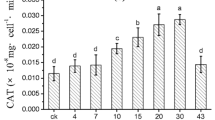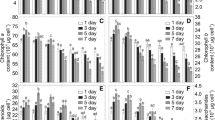Abstract
This study was conducted to investigate the influence of salicylic acid (SA) on the growth and changes of nucleic acids, protein, photosynthetic pigments, sugar content and photosynthesis levels in the green alga Chlorella vulgaris Beijerinck (Chlorophyceae). The most significant changes in the content of nucleic acids and proteins was observed at the concentration 10−4 M SA between 8 and 12 day of cultivation. This concentration of SA increased the number of cells (about 40 %) and content of proteins (about 60 %) and its secretion to the medium. The slight stimulation of protein secretion occurred on the 12th day of cultivation at concentration 10−4 M, while in the range of 10−5 M to 10−6 M the protein secretion was inhibited. SA also stimulated the content of nucleic acids, especially RNA by 20–60 %, compared with the control. The most stimulating influence upon the contents of chlorophylls a and b (50–70 %), total carotenoids (25–57 %), sugar (27–41 %) and intensity of net photosynthesis (18–33 %) was found at 10−4 M of SA. At the concentration of 10−6 M SA the slight inhibition of growth and biochemical activity of the algae was recorded at the first days of cultivation.
Similar content being viewed by others
Abbreviations
- PAR:
-
photosynthetically active radiation
- PR:
-
pathogenesis-related
- SA:
-
salicyclic acid
- SAR:
-
systemic acquired resistance
- RuBP:
-
ribulose-1,5-bisphosphate
- TMV:
-
tobacco mosaic virus
References
Bajguz A., Czerpak R. 1998. Physiological and biochemical role of brassinosteroids and their structure-activity relationship of brassinosteroids in the green alga Chlorella vulgaris. J. Plant Growth Regul., 17: 131–139.
Burkhanova E.A., Fedina A.B., Kulaeva O.N. 1999. Effect of salicylic acid and (2′–5′)-oligoadenylates on protein synthesis in tobacco leaves under heat shock conditions: a comparative study. Russ. J. Plant Physiol., 46: 11–16.
Burkiewicz K., Kentzer T. 1984. Gibberellins as extracelullar products of algae. Wiss. Z. Univ. Rostock Naturwiss. Reihe, 33: 29–30.
Czerpak R., Bajguz A. 1993. Effect of auxins and cytokinins on protein and saccharides extracelullar excretion in Chlorella pyrenoidosa. Pol. Arch. Hydrobiol., 40: 249–254.
Czerpak R., Bajguz A. 1998. Physiological and metabolical activity of salicylic acid in plants. Kosmos, 47: 83–93 [in Polish, Summ in English].
Czerpak R., Bajguz A., Bialecka B., Wierzcholowska L.E., Wolanska M.M. 1994. Effect of auxin precursors and chemical analogues on the growth and chemical composition in Chlorella pyrenoidosa Chick. Acta Soc. Bot. Pol., 63: 279–286.
Durner J., Shah J., Klessig D.F. 1997. Salicylic acid and disease resistance in plants. Trends Plant Sci., 2: 266–274.
Enyedi A.J., Yalpani N., Silverman P., Raskin I. 1992. Signal molecules in systemic plant resistance to pathogens and pests. Cell, 70: 879–886.
Fogg G.E. 1973. Extracelullar products of algae in freshwater. Arch. Hydrobiol., 5: 1–25.
Fogg G.E. 1983. The ecological significance of extracelullar products of phytoplankton photosynthesis. Bot. Mar., 26: 3–14.
Helleburt J.A. 1974. Extracellular products algal physiology and biochemistry. Bot. Monogr., 10: 838–846.
Khurana J.P., Maheshwari S.C. 1980. Some effect of salicylic acid on growth and flowering to Spirodella polyrrhiza SP20. Plant Cell. Physiol., 21: 923–927.
Klessig D.F., Malamy J. 1994. The salicylic acid signal in plants. Plant Mol. Biol., 26: 1439–1458.
Kozłowska B., Maleszewski S. 1994. Low level of inorganic orthophosphate in growth medium increases metabolism and excretion of glycolate by Chlorella vulgaris cells cultivated under air conditions. Plant Physiol. Biochem., 32: 717–721.
Larson L.J. 1989. Effect of phenolic acid on growth of Chlorella pyrenoidosa. Hydrobiol., 183: 217–222.
Lee T.T., Skoog K. 1965. Effect of substituted phenols on bud formation and growth of tobacco tissue culture. Physiol. Plant., 18: 386–402.
Lewin L.R. (Ed) 1962. Physiology and Biochemistry of Algae Academic Press, New York
Lloyd N.D.H., Canvin D.T., Culver D.A. 1977. Photosynthesis and photorespiration in algae. Plant Physiol., 59: 936–940.
Lowry O.H., Rosebrough N.J., Farr A.L., Randall R.J 1951. Protein measurement with the Folin phenol reagent. J. Biol. Chem., 193: 265–275.
Molina A., Görlach J., Volrath S., Ryals J. 1999. Wheat genes encoding two types of PR-1 proteins are pathogen inducible, but do not respond to activators of systemic acquired resistance. Molec. Plant-Microbe Interact., 12: 53–58.
Murphy A.M., Chivasa S., Singh D.P., Carr J.P. 1999. Salicylic acid-induced resistance to viruses and other pathogens: a parting of the ways? Trends Plant Sci., 4: 155–160.
Namada K.K., Kumars S., Sood V. 1976. Effect of gibberellic acid and some phenols on flowering of Impatiens balsamica, a qualitative short-day plant. Physiol. Plant., 38: 53–56.
Pancheva T.V., Popova L.P., Uzunova A.N. 1996. Effects of salicylic acid on growth and photosynthesis in barley plants. J. Plant Physiol., 149: 57–63.
Pierpoint W.S. 1994. Salicylic acid and its derivatives in plants: medicines, metabolites and messenger molecules. Adv. Bot. Res., 20: 163–233.
Pietrese C.M.J., van Loon L.C. 1999. Salicylic acid-independent plant defence pathways. Trends Plant Sci., 4: 52–58.
Pirson A., Lorenzen H. 1966. Synchronized dividing algae. Annu. Rev. Plant Physiol., 17: 439–458.
Rao M.V., Paliyath C., Ormrod D.P., Murr D.P., Watkins C.P. 1997. Influence of salicylic acid on H2O2 production, oxidative stress and H2O2 metabolizing enzymes. Plant Physiol., 115: 137–149.
Raskin I. 1992a. Role of salicylic acid in plants. Annu. Rev. Plant Physiol. Plant Mol. Biol., 43: 439–463.
Raskin I. 1992b. Salicylate, a new plant hormone. Plant Physiol. 99: 799–803.
Raskin I. 1995. Salicylic acid. In: Plant Hormones Physiology, Biochemistry and Molecular Biology, ed. by Davies P.J. Kluwer Acad Publ, Dordrecht - Boston -London: 188–205.
Ray S.D. 1986. GA, ABA, phenol interaction and control of growth: phenolic compounds as effective modulators of GA-ABA interaction in radish seedlings. Biol. Plant., 28: 361–369.
Rhoads D.M., McIntosh L. 1992. Salicylic acid regulation of respiration in higher plants: alternative oxidase expression. Plant Cell., 4: 1131–1139.
Rogers S.O., Bendich A.J. 1985. Extraction of DNA from milligram amounts of fresh, herbarium and mummified plant tissue. Plant Mol. Biol., 5: 69–76.
Sambrook J., Fritsch E.F., Maniatis T. 1989. Molecular cloning. A laboratory manual. CSH Lab Press.
Sayegh A., Greppin H. 1973. Chlorella rubescens Ch Essai de synchronisation et mise en evidence de rythmes endogenes. Arch. Sci. Geneve, 8: 6–18.
Somogyi M. 1952. Notes on sugar determination. J. Biol. Chem., 195: 19–23.
Stewart W.D.P. 1974. Algal Physiology and Biochemistry, Blackwell Scientific Publisher, Oxford.
Ward E.R., Uknes S.J., Williams S.C., Dincher S.S., Wiederhold D.L., Alexander D.C., Ahl-Goy P., Métraux J.P., Ryals J.A. 1991. Coordinate gene activity in response to agents that induce systemic acquired resistance. Plant Cell, 3: 1085–1094.
Watanabe Y. 1980. A study of excretion and extracelullar products of natural phytoplankton in Lake Nakanuma. Japan Intern. Rev. Ges. Hydrobiol., 65: 809–8341.
Wellburn A.R. 1994. The spectral determination of chlorophylls a and b, as well as total carotenoids, using various solvents with spectrophotometers of different resolution. J. Plant Physiol., 144: 307–313.
Wobbe K.K., Klessig D.F. 1996. Salicylic acid — an important signal in plants. In: Signal Transduction in Plant Growth and Development, ed. By Verna D.P.S. Series: Plant Gene Research, Springer-Verlag: 167–196.
Zhang S., Klessig D.F. 1997. Salicylic acid activates a 48 kDa MAP kinase in tobacco. Plant Cell, 9: 809–824.
Author information
Authors and Affiliations
Rights and permissions
About this article
Cite this article
Czerpak, R., Bajguz, A., Gromek, M. et al. Activity of salicylic acid on the growth and biochemism of Chlorella vulgaris Beijerinck. Acta Physiol Plant 24, 45–52 (2002). https://doi.org/10.1007/s11738-002-0020-x
Received:
Accepted:
Issue Date:
DOI: https://doi.org/10.1007/s11738-002-0020-x




